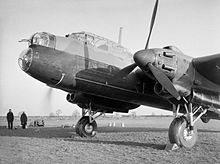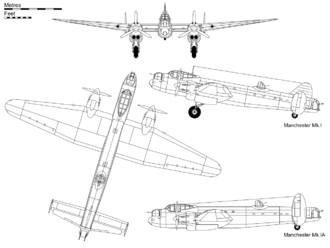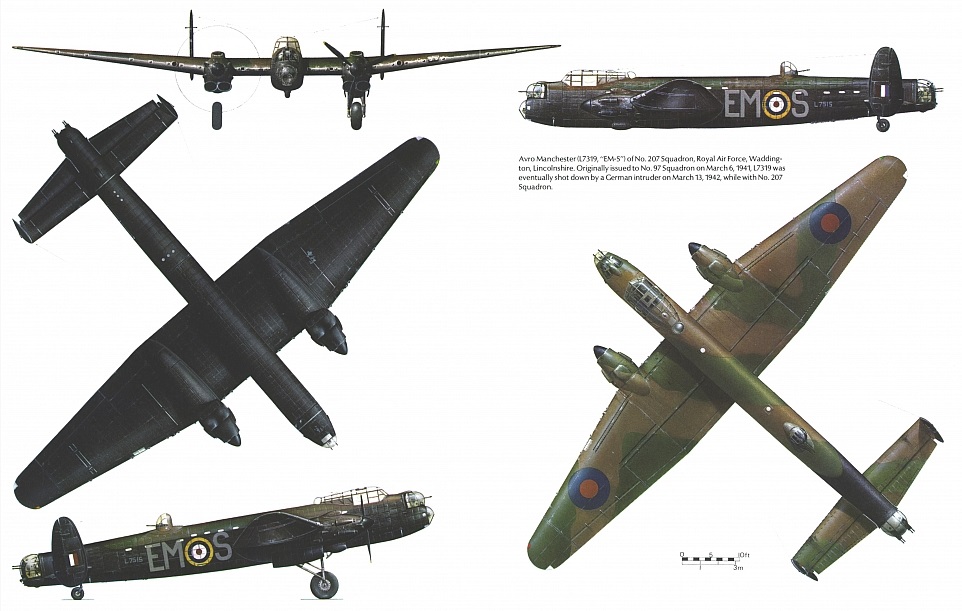A request for an early war British bomber: With the Whitley, Wellington and an WIP Hampden available there is one other forgotten bird of the early desperate days of WW2, The Avro Manchester IA.
Originally designed to the Air Ministry Specification P.13/36 issued in May 1936, for a twin-engine monoplane "medium bomber" for "worldwide use", which was to be capable of carrying out shallow (30°) dive bombing attacks and carry heavy bombloads (8,000 lb/3,630 kg) or two 18 in (457 mm) torpedoes.
202 total copies of MK1 & MK1A were manufactured between 1940-1941 and 193 planes equipped 9 total Squadrons till 1942:
Royal Canadian Air Force
No. 408 Squadron RCAF
No. 420 Squadron RCAF
Royal Air Force
No. 49 Squadron RAF at RAF Scampton (April 1942-June 1942)
No. 50 Squadron RAF at RAF Skellingthorpe (April 1942-June 1942)
No. 61 Squadron RAF at RAF Hemswell (June 1941-June 1942)
No. 83 Squadron RAF at RAF Scampton (December 1941-June 1942)
No. 97 Squadron RAF at RAF Waddington then RAF Coningsby (February 1941-February 1942)
No. 106 Squadron RAF at RAF Coningsby (February 1942-June 1942)
No. 207 Squadron RAF at RAF Waddington then RAF Bottesford (November 1940-March 1942)
No. 25 Operation Training Unit at RAF Finningley
No. 44 Conversion Flight
No. 1485 Flight RAF
No. 1654 Heavy Conversion Unit
No. 1656 Heavy Conversion Unit
No. 1660 Heavy Conversion Unit
No. 1668 Heavy Conversion Unit
Airborne Forces Experimental Establishment
Torpedo Development Unit at RAF Gosport
The 193 operational Manchesters flew 1,269 sorties with Bomber Command, dropping 1,826 tons (1,657 tonnes) of bombs , flying its last operation against Bremen on 25 June 1942. 46 Manchester medium bombers flew in Operation Millennium. During it's operational life 78 aircraft were lost in action and a further 45 were non-operational losses of which 30 involved engine failure. The Manchester was withdrawn from operations in mid-1942 in favour of more capable aircraft. While the Manchester was an operational failure because of its underdeveloped, underpowered and unreliable engines, it was the forerunner of the successful four-engined Avro Lancaster when a Manchester MK III (serial number BT308) was fitted with an extended longer wing and four Rolls-Royce Merlins in new power-egg nacelles and flew on 9 January 1941, becoming essentially the first Lancaster. The Manchester's final role in RAF service was as instructional trainers for converting crews to the RAF's new Lancaster bombers; the Manchester and Lancaster shared nearly identical crew positions and fuselages. The type persisted in use for training purposes into 1943 before being completely retired.
General characteristics
Crew: 7
Length: 70 ft (21.34 m)
Wingspan: 90 ft 1 in (27.46 m)
Height: 19 ft 6 in (5.94 m)
Wing area: 1,131 ft² (105.1 m²)
Empty weight: 31,200 lb (14,152 kg)
Max. takeoff weight: 50,000 lb (22,680 kg)
Powerplant: 2 × Rolls-Royce Vulture I 24-cylinder X-type, 1,760 hp (1,310 kW) each
Performance
Maximum speed: 265 mph (230 kn, 426 km/h) at 17,000 ft (5,180 m)
Range: 1,200 miles (1,930 km) with maximum bomb load of 10,350 lb (4,695 kg)
Service ceiling: 19,200 ft (5,852 m)
Armament
Guns: 8 × 0.303 in (7.7 mm) Browning machine guns, (in Nash & Thomson nose (2), dorsal (2) and tail (4) turrets)
Bombs: 10,350 lb (4,695 kg) bomb load
I know that is is not as simple as just removing two engines from the Lancaster, but it would be an easier request than making it from scratch.
Thank you for your consideration.
Video:




 Author
Topic: Avro Manchester IA request (Read 3143 times)
Author
Topic: Avro Manchester IA request (Read 3143 times)


